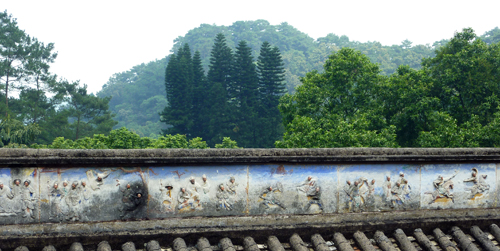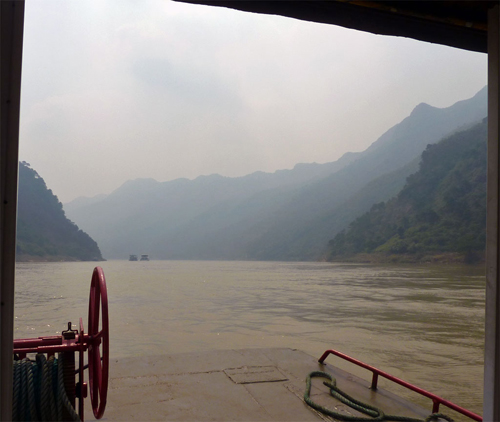Fei Lai 飞来 & Fei Xia 飞霞
It just shows how much things have changed in China: according to our rather dated guidebook, the train from Guangzhou to Qingyuan 清远 should have taken around two hours to cover the 80 kilometers between the two cities. Not anymore! It now takes about twenty minutes to whizz you from one place to the other on one of China’s new high- speed trains. And they even feed you breakfast – of sorts – in that time!
It actually takes longer to do the 15- kilometer ride on the underground from Central Guangzhou to the new Guangzhou South station 广州南站, than it does to travel to Qingyuan.
Why does one go to Qingyuan?
The answer is mainly to visit the secluded temples of Fei Lai飞来and Fei Xia飞霞that are almost exclusively reached by boat along the Beijiang River.
Qingyuan’s high speed station is just a kilometer from the quay – not the one mentioned in the guidebook – from where you catch the boat upstream to visit these out-of-the-way temples. Fei Lai is situated on the river bank, while Fei Xia is hidden high up and spread out in deep forests. Local taxis, aware that the rare foreigners who venture out here haven’t got a clue, will pounce on you and try to charge exorbitant prices for the 3-minute drive to the quay, but really, it should cost no more than 5 Yuan. Walk!
Once at the quay, you’ll realize this isn’t going to be a cheap, independent excursion; there are no more small boats with eager local fishermen, willing to do the trip for a reasonable price.
The only boats (that we saw) for hire are large hulks that can carry up to 30 people and cost an astronomical 700 Yuan each. We were therefore somewhat relieved to find a Spanish couple hanging around the quay as well. At least between 4, the cost was quite bearable.
Before heading off, your boatmen will advise you to buy some fresh fish and seafood at the local shop. Fresh water mussels are all the rage here. This is because Chinese tourists and pilgrims have the tradition of taking the food to the floating houses cum restaurants at Fei Xia to have it cooked. Apparently, this is a cheaper option than actually ordering the food there. We just stocked up on cold beer and snacks.
The boat quay is very close to the entrance to the gorge and you arrive at the first temple, Fei Lai, after about 20 minutes.
Fei Lai Gusi 飞来古寺
Fei Lai Gusi (entrance 15 Yuan) has been around for 1400 years, but the actual temple is a relatively modern construction; the previous temple was destroyed in a landslide in 1997. Nevertheless, its setting on the banks of the muddy Beijing River 北江 is gorgeous, and the -sweaty- climb up the hill to a small pavilion is rewarded by wonderful views.
A friendly monk at the pavilion will offer you some water if you haven’t brought your own. Remember that the heat in summer is pretty unbearable!
If you didn’t buy any fresh water mussels or carp at Qingyuan’s quay, you apparently have another opportunity to get them from locals at the pier in front of Fei Lai. However, we didn’t see anything appetising, and just got some more cold beers to combat the heat. Thirst, not hunger, was first and foremost on our minds.
Fei Xia Gusi 飞霞古寺
Next, it’s on to Fei Xia, a further 3 kilometers upstream. This area has been slightly more developed for domestic Tourists, though it’s still extremely laid back for a Chinese tourist site. It’s at the quay of Fei Lai where the Chinese have their seafood cooked in floating restaurants. However, on the day we visited, the floating markets cum restaurants were virtually abandoned and didn’t look that appealing; or hygienic…
Many local tourists don’t even bother with the climb or bus ride up the hill to the main temple complex and content themselves with eating and drinking, or a quick visit to the lower temples of recent construction.
There are two options to reach Fei Xia: you can follow the steps up through the wood, or take the bus that’s included in the entrance ticket (which is rather expensive at 60 Yuan). The bus winds its way up through thick forest by a series of hair-pin bends; the steps cut through the steep forest. As it was so hot, we opted for the bus.
The bus route finishes at a large temple complex; fairly modern, but with nice views. Don’t make the same mistake we made, assuming this was it! This temple is just a prelude to an even bigger complex, another kilometer away. All in all, Fei Xia is an interesting place; more like a Dracula-esque medieval castle than a temple, with passageways, hidden courtyards and steep steps.
The temple is quite spread- out and has many different halls, pagodas and courtyards, linked by beautiful, shaded and tree- lined paths. The main part of the temple seems to climb endlessly up into the deep forest.
There was quite a lot of restoration going on while we were there, so it might be looking even more attractive in the future.
Like at Feilai, the views from Fei Xia over the river and mountains are spectacular. The only problem was the heat, which drained our enthusiasm for further exploration. If you’re feeling adventurous, there are pagodas and smaller temples hidden away in the forest, reached by not very well sign-posted paths.
Getting there and away
Take the high- speed train from Guangzhou’s Southern station 广州南站. Depending on the train, it takes between 10 and 20 minutes to get to Qingyuan station 清远站. The quay is about a kilometer away. Turn right out of the station and walk until you reach the river and turn right again down to the quay. A taxi is expensive, as the drivers claim they are losing a more lucrative ride to Qingyuan town. We were able to get same day tickets to and from Qingyuan without any problem, but you can also book in advance. However, we did have to wait quite a while in Qingyuan station to catch a train back that had a couple of empty seats.
Our boat trip through the gorge and visiting the temples took around 4 hours altogether. The actual time spent on the boat is quite short. Most of the time is spent visiting the temples, especially Fei Xia. Count on more time if you are going to eat in the floating restaurants as well. As I said earlier, the boat cost 700 Yuan, and I couldn’t see any other options. If there aren’t any other travellers, you’ll have to try and get in with some Chinese tourists at the quay; If there are any!



















